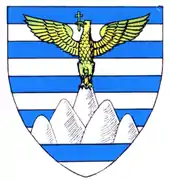Ținutul Argeș
Ținutul Argeș (or Ținutul Bucegi) was one of the ten Romanian ținuturi ("lands") founded in 1938, after King Carol II initiated an institutional reform by modifying the 1923 Constitution and the law of territorial administration. Named after the Argeș River and extending over historical areas of Wallachia and parts of Transylvania (Székely Land), it had its capital in the city of Bucharest. Ținutul Argeș ceased to exist following the territorial losses of Romania (Second Vienna Award) and the king's abdication in 1940.
Ținutul Argeș
Ținutul Bucegi | |
|---|---|
Land (Ținut) | |
 Coat of arms | |
 | |
| Country | |
| Former counties included | Argeș County, Brașov County, Buzău County, Dâmbovița County, Ilfov County, Muscel County, Prahova County, Teleorman County, Trei Scaune County, Vlașca County |
| Historic region | Wallachia (Muntenia) and parts of Transylvania |
| Capital city (Reședință de ținut) | Bucharest |
| Established | The administrative reform of 1938 |
| Ceased to exist | Territorial loss and new administrative law (30 August 1940) |
| Government | |
| • Type | Rezident Regal |
| Time zone | UTC+2 (EET) |
| • Summer (DST) | UTC+3 (EEST) |
Coat of arms
The coat of arms consisted of ten bars, five of azure and five of argent, representing the former ten counties (județe) of Greater Romania (71 in total in 1938) included in it, charged with or eagle wings displayed facing dexter with an or Latin cross in the beak (elements taken from Wallachia's historical coat of arms) standing over five peaks argent representing the Bucegi Mountains.
Former counties incorporated
After the 1938 Administrative and Constitutional Reform, the older 71 counties lost their authority; of those, 10 were incorporated in Ținutul Argeș.